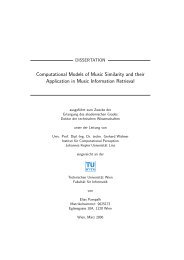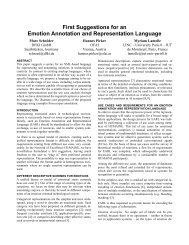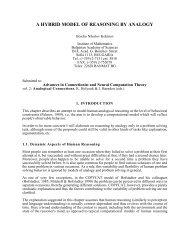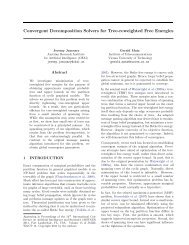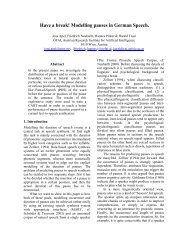Global Musical Tempo Transformations using Case Based ... - OFAI
Global Musical Tempo Transformations using Case Based ... - OFAI
Global Musical Tempo Transformations using Case Based ... - OFAI
Create successful ePaper yourself
Turn your PDF publications into a flip-book with our unique Google optimized e-Paper software.
All Of Me<br />
4<br />
P ID P P<br />
Figure 3.6: First measures of ‘All of me’, with corresponding I/R structures.<br />
3<br />
such an analysis for the first measures of the jazz song ‘All of me’. Assuming<br />
that the violation or realization of implications is an essential aspect of the<br />
way humans listen to music, this sequence of structures is would reflect the<br />
listener’s representation of the melody.<br />
Interesting experiments have been carried out by Schellenberg [105, 106]<br />
and Cuddy and Lunney [29], in which they presented subjects with either a<br />
melody [105, 106] or a single melodic interval [29] and asked them to rate<br />
different continuations. These ratings were compared with predictions of<br />
the I/R model (where the effect of the different I/R principles was quantized<br />
by the authors in accordance with the model). It turned out that the<br />
I/R model was able to predict listeners’ ratings well above chance level. A<br />
principal-component analysis of the five I/R principles under consideration<br />
(registral direction, intervallic difference, proximity, closure and registral return)<br />
showed that the model was redundant, in the sense that three of the<br />
principles were highly correlated. Additional experiments were done with<br />
revised versions of the principles. Eventually Schellenberg [106] proposed a<br />
simplified version of the I/R model containing two principles, of which the<br />
first corresponds to revised versions of registral direction/registral return and<br />
the second to proximity. The proximity principle states that listeners prefer<br />
smaller realizing intervals to larger realizing intervals, i.e. small intervals<br />
are more implied than large intervals, regardless of the size of the implicative<br />
interval. The pitch-reversal principle (Schellenberg’s term for the linear<br />
combination of the revised registral direction and registral return principles)<br />
states that listeners prefer the second tone of the realizing interval to be close<br />
to the first tone of the implicative interval. As Schellenberg points out, this<br />
principle extends the proximity principle to tones that are non-contiguous.<br />
Schellenberg found this simplified I/R model to predict listeners responses<br />
better than the original I/R model proposed by Narmour.<br />
3.5.2 Melodic Similarity<br />
In a CBR system where problem descriptions contain melodies, the concept<br />
of melodic similarity will in some form or other have to play a role in the<br />
50




